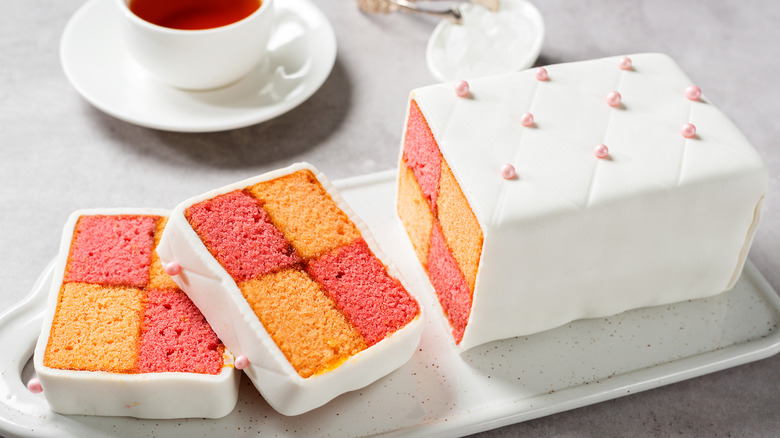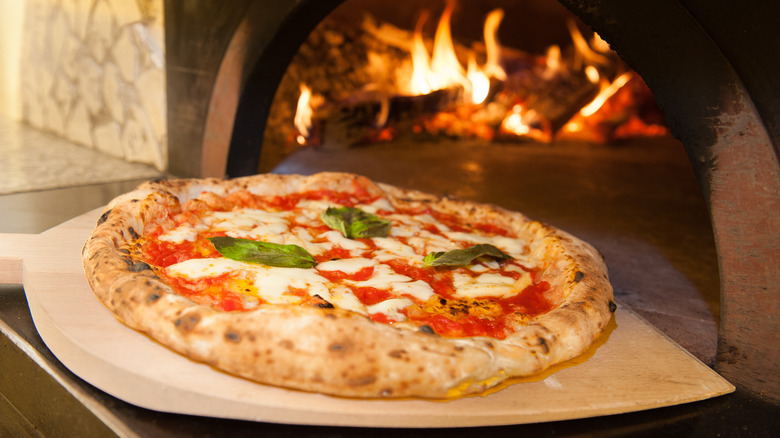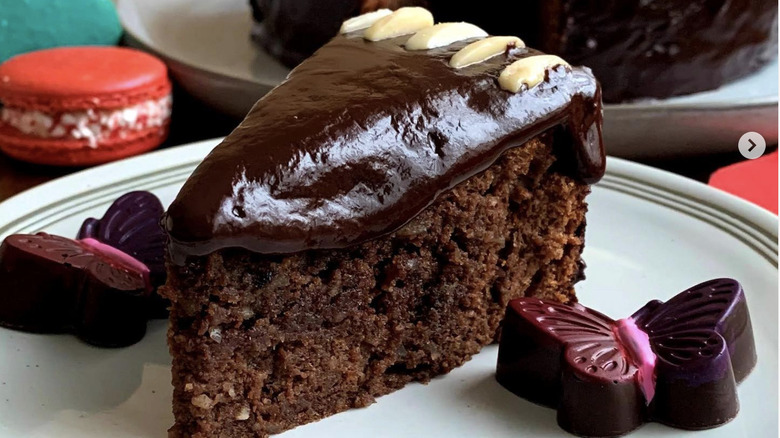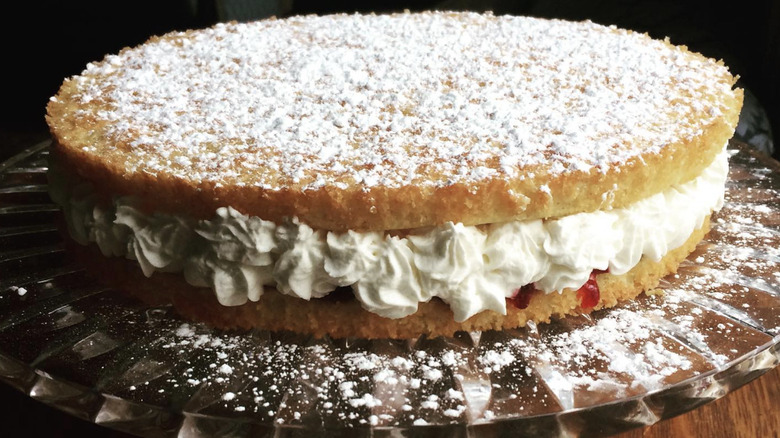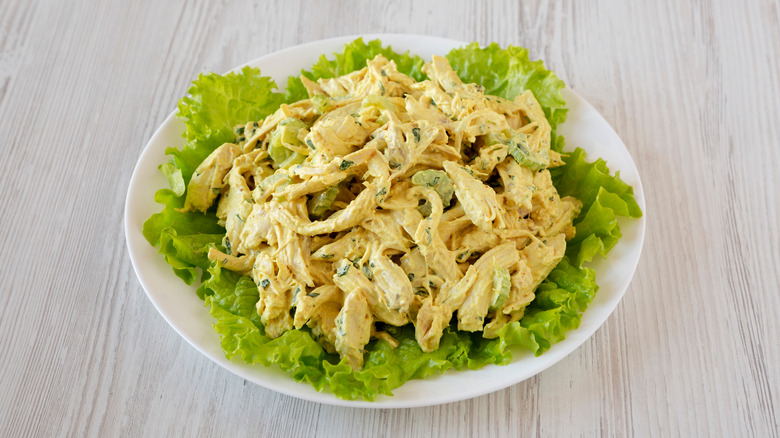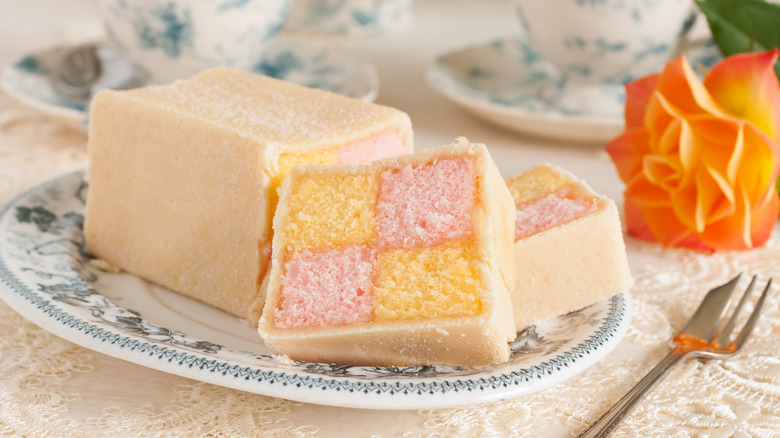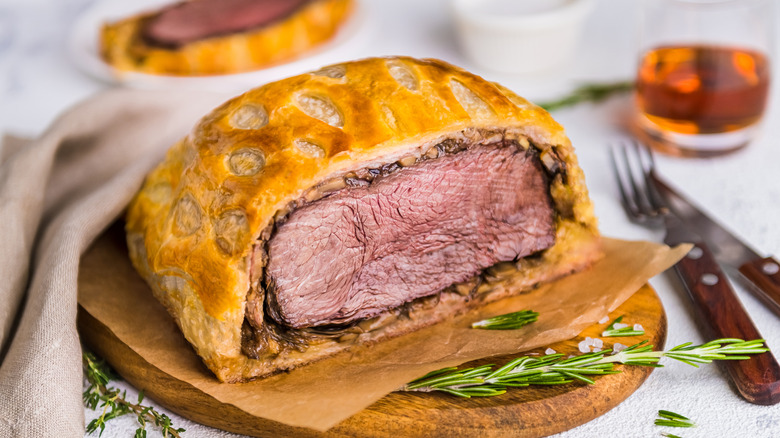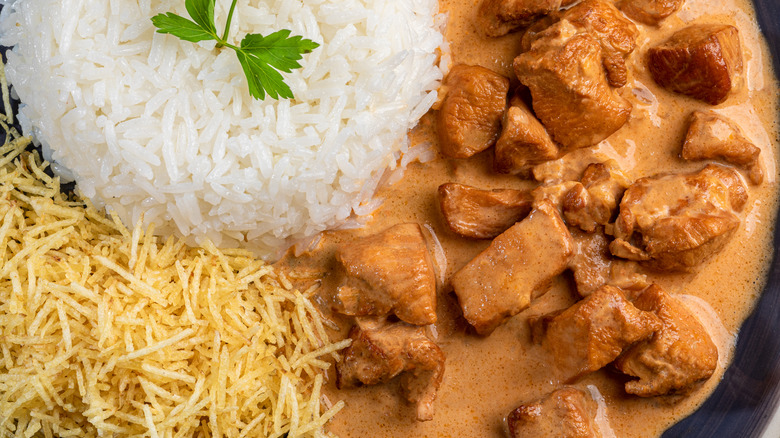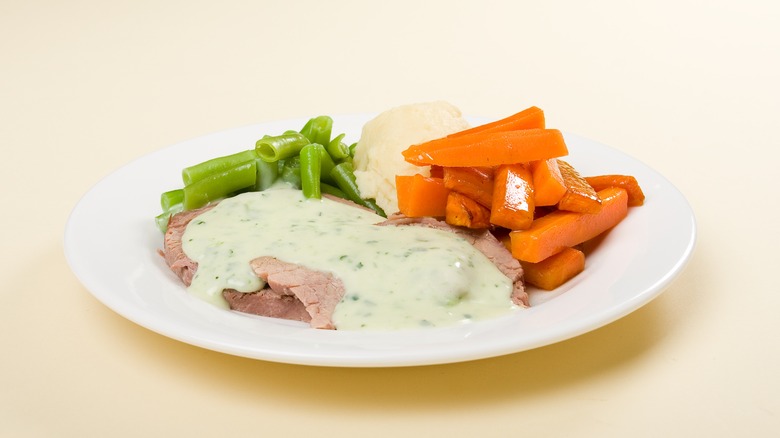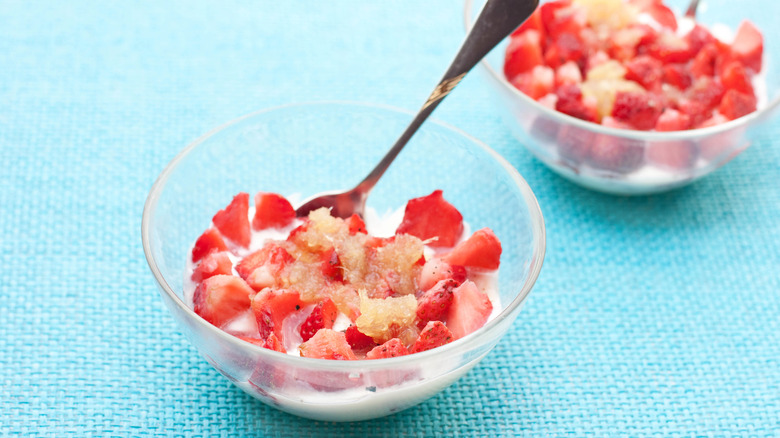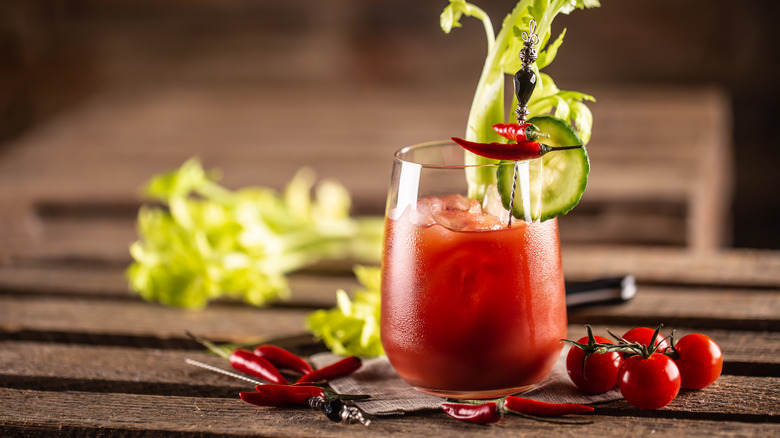Popular Dishes Named After Royalty
It's not uncommon to find streets, public buildings, and even airports named after celebrities, politicians, authors, and nobility. From Malcolm X Boulevard in New York City to the George Bush Intercontinental Airport in Houston, we are surrounded by infrastructure that pays tribute to famous people. And food is no different. From mains, sides, and desserts to drinks, culinary creations inspired by well-known personalities are often hidden in plain sight (via Almost History).
Royals have influenced what we eat for centuries. For example, the Georgian royals have been credited with introducing continental food to the U.K. (via History Extra). As such, it's little wonder that so many dishes have been named after nobility. From meals invented to honor kings and queens to dishes created for significant events such as weddings and coronations, food names have been used to immortalize nobility for centuries. With this in mind, here're some of the most popular dishes named after royalty.
Pizza Margherita
Simple yet delicious, Margherita is the time-tested, go-to pizza option in times of doubt. And while most of us have tried the pizza classic, not many are aware of how the mozzarella, tomato, and basil pie came into existence. According to numerous accounts, Pizza Margherita was invented in Naples for the visit of the Queen of Italy, Margherita of Savoy, in 1889. Before her visit, the monarch enlisted chef Raffaele Esposito of Pizzeria Brandi to cater for her visit. Inspired by the local cuisine, Esposito made three different pizza variations: Pizza Napoli, Pizza Marinara, and what we know today as Pizza Margherita. While the first two weren't to the queen's liking, the third hit the spot — or so the story goes (via History Hit).
In reality, it's unlikely that Pizza Margherita was named after the Italian queen. This is because the use of the three distinct pizza toppings was already popular in Naples prior to Queen Margherita's 1889 visit. In fact, the combination of ingredients was already described in a book in 1866. An alternative theory about the origins of the dish relates to the specifics of the word "margherita." It's said that the term, which translates to daisy in Italian, could actually be referring to the petal-like arrangement of the mozzarella slices on the pizza (via Atlas Obscura).
Queen Mother's Cake
While the origins of chocolate cake can be traced back to 1764, when it was discovered that grinding cocoa beans between two millstones produced chocolate, there is a specific variation of the sweet treat that may have taken its name from royalty (via Oh Lovely Lolo). Queen Mother's Cake is said to have gained its name after the dessert was introduced to Queen Elizabeth, also known as the Duchess of York, by the renowned Polish pianist Jan Smeterlin in the 1950s.
The story goes that the Queen Mother became partial to the cake after it was served to her at Smeterlin's home. The pianist, in turn, acquired the recipe for the dessert when he was on tour in Austria (via Unofficial Royalty). In fact, it's said that the Queen Mother loved the cake so much that she asked Smeterlin for the recipe and promptly started serving it to her guests. Today, Queen Mother's Cake is a hit in both the U.K. and Australia — a country she visited on several occasions. So what about the flavor? According to In the Vintage Kitchen, the fluffy cake with glossy frosting tastes similar to a fudge brownie, but less dense.
Victoria Sponge Cake
Also sometimes called Victoria Cake and Victoria Sandwich, Victoria Sponge Cake is an airy cake with two layers separated by jam and whipped cream. The cake is typically served in small, sandwich-like pieces (via What's Cooking America). The origins of Victoria Sponge Cake can be traced back to the ritual of Afternoon Tea, which is said to have been invented by Anne Russell, the 7th Duchess of Bedford, who would get peckish before the evening meal. Russell soon began inviting friends — including Queen Victoria — to share her Afternoon Tea, and the practice gradually turned into a trend (via Grants Baker).
One of Queen Victoria's favorite Afternoon Tea treats was sponge cake, a dessert that had already been mentioned in a recipe book way back in 1615. The queen was said to love the cake so much that over the years, a version of the dessert was renamed in her honor. According to Anges de Sucre, the main factor that distinguished Victoria Sponge Cake from simple Sponge Cake was the addition of baking powder, a food additive invented in 1843. Usually made with flour, eggs, sugar, and butter, the exact ingredients of Victoria Sponge Cake and their quantities are often disputed.
Coronation Chicken Salad
Queen Elizabeth II ascended to the throne after the passing of her father King George VI in 1952, a time when Britain was still recovering from World War II. Her 1953 coronation was an important event and needed to be marked as such with a culinary feat — this is when Coronation Chicken Salad was born (via CS Monitor). The chicken in curried mayonnaise is said to have been invented by chef Rosemary Hume and food writer and florist Constance Spry who at the time were principals at the Cordon Bleu Cookery School in London (via Tina's Traditional). According to another theory, it was Hume who came up with the recipe, while Spry took the credit for the invention (via KQED).
Originally called Poulet Reine Elizabeth, Coronation Chicken Salad was probably based on Jubilee Chicken, which was prepared for the Silver Jubilee of George V in 1935. The recipe served at Elizabeth II's coronation banquet was rather complex, and called for white wine, apricot purée, onions, mayonnaise, and whipped cream. It was published ahead of the coronation to enable the common folk to enjoy the dish in the comfort of their homes while watching the event on TV (via Scrumpdillyicious). Today, the most popular version of the dish consists of mayonnaise, curry powder, and dried fruit such as raisins and cranberries.
Battenberg Cake
Battenberg Cake is composed of yellow and pink strips of cake arranged checkerboard-style with a layer of jam between them. The proverbial icing on the cake comes in the form of marzipan glaze. The original recipe for the cake called for nine squares, but this number was reduced to four when it started being mass-produced just before World War II (via English Heritage). Over the years, the dessert has been given various names, including Neapolitan Roll, Domino Cake, and Church Window Cake (via British Food and Travel).
There are various theories about the cake's origins. One that seems to appear most often, however, is that it was invented in 1884 to celebrate the marriage of Queen Victoria's granddaughter Princess Victoria to Prince Louis of Battenberg. According to another theory, the four squares of Battenberg Cake represent Prince Louis and his three brothers — Henry, Francis, and Alexander (via Unofficial Royalty). The earliest mention of the recipe for Battenberg Cake didn't make it into print until 1898, which somewhat undermines the wedding theory.
Beef Wellington
There's little doubt that all carnivores appreciate the taste of a well-made Beef Wellington. The juicy prime beef filet and duxelles wrapped in flaky pastry is the signature dish of Chef Gordon Ramsay, who serves it at his restaurants. In fact, the celebrity chef has said that the dish would "definitely be on [his] last supper menu" (via Gordon Ramsay Restaurants).
So what are the origins of Beef Wellington? The stories vary. However, the most popular is that the dish was named after the Duke of Wellington, Arthur Wellesley, who was given the title in 1814. While we don't really know the exact connection between the duke and Beef Wellington (other than the title itself), he is famous for leading Britain to victory during the Napoleonic wars. He is also known for being the Prime Minister of the country and a huge fan of Wellington boots.
The tradition of wrapping meat in pastry has a long history. In fact, Beef Wellington resembles the French Filet de Boeuf en Croûte, which was already around before Wellesley defeated the French at the Battle of Waterloo in 1815. Perhaps the most likely explanation is that the culinary masterpiece was simply renamed Beef Wellington after the duke's victory (via Food Reference).
Beef Stroganoff
Reaching its peak of popularity in the U.S. in the 1950s and 1960s, Beef Stroganoff is a hearty dish composed of sautéed pieces of beef in a cream sauce (via the Moscow Times). While the dish is undoubtedly Russian in origin, over the years different stories have circulated about its exact history. One theory is that Beef Stroganoff was invented by a French chef, Charles Brière, who worked for Count Pavel Alexandrovich Stroganov and named it after his employer. More specifically, Brière is believed to have created the recipe for the Russian L'Art Culinaire in 1891. It's even been said that the dish features small pieces of beef since the count's teeth were no longer up to the job of chewing larger chunks of meat (via Fork n Plate).
The Count Pavel Alexandrovich Stroganov theory doesn't stand up to scrutiny, though, since the count died in 1817. While Brière may have taken credit for the recipe, he probably didn't invent it. In fact, a recipe for Beef Stroganoff with Mustard already appeared in "Gift to Young Housewives" in 1861. And while the recipe is much simpler than the Beef Stroganoff we know and love today, it clearly is a predecessor to the current version of the dish.
Béarnaise Sauce
Béarnaise Sauce is a variation of Hollandaise Sauce (which is a French mother sauce because it can be used as a base for other sauces, including Béarnaise). While Hollandaise Sauce is made with egg yolks, butter, and lemon juice, Béarnaise Sauce takes this concoction a step further with the addition of white wine vinegar, tarragon, and shallots, and the removal of lemon juice (via Masterclass). The sauce is commonly used on steaks, seafood, and poultry, as well as on vegetables such as potatoes and asparagus. It's also sometimes eaten with eggs as an alternative to Hollandaise Sauce (via Recette Magazine).
Béarnaise Sauce was created by chef Jean-Louis Françoise-Collinet in the 1830s, and was first served to celebrate the opening of the Le Pavillon Henri IV restaurant in 1836. According to one theory, the condiment was named after King Henry IV of France, who was nicknamed "le Grand Béarnaise" (via Saveur). However, since Béarnaise translates to "from Bearn" in French, Béarnaise Sauce might simply be referencing the province of King Henry IV's birth.
Strawberries Romanoff
While there are a few variations of this dessert, Strawberries Romanoff is typically made with marinated and chilled strawberries and whipped cream. Adult versions of the recipe usually also contain orange-flavored liqueur, while child-friendly versions come with juice (via Noah Sheetz). Due to its name, it's sometimes asserted that the dessert was invented by the chef of Nicholas I from the Romanoff family. This story, however, is very unlikely to be true.
It's generally accepted that the classic dessert was first created by chef Auguste Escoffier at the Carlton Hotel in London in the 1920s, when it was called Strawberries Americaine Style. In the 1940s, Escoffier's recipe was appropriated by Prince Michael Romanoff, a Hollywood restaurateur and con man who claimed to have imperial Russian heritage (via Canapes and Chocolate). The self-proclaimed royal was actually given the "accolade" of "the most wonderful liar in the 20th century U.S." by Life magazine (via LA Times). And while the so-called "Prince" Michael Romanoff may have been a fraud, he was successful in renaming Strawberries Americaine Style to Strawberries Romanoff.
Bloody Mary
Okay, so a Bloody Mary isn't a dish. Nevertheless, we found the history of this brunch cocktail interesting enough to include it in this list. The savory drink was invented at Harry's New York Bar in Paris in the 1920s. The story is that the bar was opened in 1911 by an American jockey who shipped his New York bar to Paris. During the Prohibition era, the bar became a favorite hangout for Americans living in the French city.
In the 1920s, escapees from the Russian revolution brought vodka to Paris. The bartender at Harry's, Ferdinand "Pete" Petiot, started experimenting with the liquor, eventually combining it with tomato juice and spices. Petiot later brought the drink recipe to New York City, where he was managing the King Cole Bar at the St. Regis Hotel. He added Tabasco sauce, horseradish, lemon juice, and celery salt to the concoction and named it Red Snapper — a name that ultimately didn't stick (via The Real Dill).
According to one theory, the cocktail was named Bloody Mary after Queen Mary Tudor. More specifically, the red color of the drink is said to represent the blood lost during the queen's reign in 16th century England — she is mainly remembered for the hundreds of Protestants she had executed. Another tale claims that Petiot dubbed his creation Bloody Mary after a patron said that the cocktail reminded him of a girl named Mary from a Chicago club called Bucket of Blood Club (via Best Bloody Mary).
